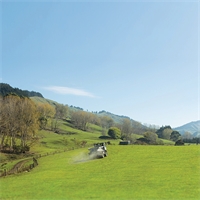30Aug
New Hybrid for Better Production
This promotional feature was supplied by Agricom.
Mohaka is bringing a new name to the hybrid ryegrass category with new, high producing genetics and the ability to produce yield through late winter and the shoulders of summer. Farmers that are looking to increase ryegrass production over a 2-4 year rotation now have the answer with Mohaka.
Currently, hybrid ryegrasses are receiving more and more interest in areas where persistence from long term ryegrass is an issue. The ability to grow more feed from a hybrid ryegrass over a similar period is gaining more traction. As a system fit this gives more options to farmers who are looking at placing a high-quality tetraploid ryegrass with large yield potential into a rotational plan.
Mohaka hybrid ryegrass is a tetraploid meaning it has “four sets of chromosomes per cell”. Mohaka offers fast establishment speeds with high all-year-round production, while also maintaining exceptional quality due to its tetraploid genetics and low aftermath seeding. The new generation breeding of Mohaka means it is bred from other hybrid ryegrass genetics with a proportion of 60-65% long-lived hybrid genetics and 35-40% Italian. The Italian genetics enable strong establishment and winter production, while the long-lived genetics aid in persistence and production during the tougher months of summer and autumn.
Mohaka can be used as a short to medium term pasture for sheep and beef finishing. For a tetraploid hybrid pasture, it has good density for short periods of set stocking and winter grazing. It has a good spring growth habit while maintaining low aftermath seeding in summer, helping with pasture quality through summer and into autumn for mating.
Mohaka is highly suited to dairy runoff and supplementary feed pastures. The strengths of autumn and winter production help with pasture cover at these critical times while its summer leafiness will maintain high-quality summer silage production.
Farmers looking to grow high-quality finishing and/or milking feed are well suited for the introduction of Mohaka to their system. The seasonal growth of Mohaka means farmers can grow more feed in the winter and spring and the late heading date means it will keep producing high-quality drymatter later into the spring. The addition of Relish red clover and Tribute white clover will help to increase the production and quality of the feed source offered to stock and in return increase production per hectare.
To get the most out of your paddock of Mohaka, following best practice establishment procedures is important. Ensure your soil is free from weeds and then create a fine, firm and even seedbed. When direct drilling, make sure to not drill the seed too deep. Establishment rates of Mohaka will vary, with a full sward being sown at 25-30 kg/ha, depending on the addition of clovers or other herbs, or undersow into existing pasture at rates of 15-20 kg/ha.
Mohaka AR37 has shown its merit within the New Zealand Forage Variety Trials. Currently, it is a leading variety in the hybrid category in trials conducted south of Taupo*. Mohaka is available with AR37 endophyte to cover a wide insect-pressure spectrum and is now also available, in limited volumes, with AR1 endophyte for deer or lamb finishing pastures where Argentine Stem Weevil is the main insect problem.
If you are looking for an all round performer with excellent winter growth and summer sustainability talk to your local Ruralco representative about Mohaka.
Related

There are several factors that contribute to low magnesium (Mg) levels in pasture and stock. Soil an...
Read More

Farming, like professional sport, is a job with plenty of challenges. That’s why it’s important to...
Read More

Fuel is a key cost to any business. With your Ruralco Cards you’ll consistently save at least 12c* ...
Read More

After weaning, the focus has traditionally gone onto the lamb crop, but for ewes, the period between...
Read More

On the winding back roads in New Zealand’s beautiful South Island are two humble Kiwi blokes, Kylie...
Read More

Tony Aitken is the first to admit he’s no expert when it comes to farming. Instead, Tony’s experti...
Read More